Reading the Cards
In this book I present the open reading, which is my way of reading the tarot cards. The original inspiration for the open reading came from the teachings of Alejandro Jodorowsky, whose lectures and workshops I attended for three years in Paris during the 1980s. Later I developed and added to it from my own ideas and experiences. The open reading approach can be applied to different kinds of cards. But its full potential emerges through the Tarot de Marseille, the product of many centuries of trial and error, adaptation and evolution.
The following three points can summarize the open reading approach and the way in which it differs from more conventional methods. First, a tarot card does not have a fixed meaning that can be learned in advance; rather, the meaning emerges from what we can see in the card during the reading. Second, the function of each position in a spread is also not fixed; rather, it depends on the combination of cards that actually appear. Third, we don’t start by interpreting each card separately; instead, we first try to see the whole picture that the cards form together. We shall discuss these points in detail throughout the rest of this chapter.
In the open reading approach, the meaning of a tarot card is what we see in its illustration when we do the actual reading. This means that there is no point in memorizing “the meaning of each card” beforehand. In other words, a tarot card is not a symbol with some fixed meaning that we should retrieve from our memory when we see it in the reading. Instead, it is a visual tool that stimulates our perception and brings up messages from the unconscious part of our mind when we look at it.
Of course, previous knowledge about the cards is useful. The card illustrations are complex and tricky. There are many things in them that we don’t notice on first sight, and a good acquaintance with the card details can guide our attention toward them. Also, the symbols in the cards are charged with cultural, philosophical, and mythological meanings. Knowledge about these symbols and their significance, whether in general culture or in different schools of tarot reading, can suggest a wide range of associations when we look at a card. But all this prior knowledge should not limit our ability to see the cards in a fresh perspective each time and to let them lead us in new and unexpected directions.
The important point here is that the cards are a visual tool that works directly on the unconscious layers of our mind. In looking at the cards, what we see reflects what we feel deep inside, but the visual impression that the card makes on us will be different each time. Therefore, the meaning of the card cannot be fixed once and for all. Rather, the visual appearance of a card depends on the whole context of the reading.
Several factors contribute to this difference in visual impression. First, the card looks different when other cards are placed beside it. Second, the querent’s presence and query have an emotional effect on us, which influences our ability to see certain things in the card and ignore others. Third, we are also not the same. We come to each reading with a different life experience and in a different emotional state.
To be sure, the fact that the card meaning changes each time does not mean that we shouldn’t trust the message that we see in it. As discussed in Chapter 2, in each card reading everything is a sign. This includes not only the choice of cards in the spread, but also the fact that this querent chose to come to us at this particular moment. In other words, it is possible that the querent would get a similar answer from a different reader working with different methods. But in such a case, the shuffling would also be different and the answer would come from looking at different cards. The cards tune themselves to the general context of the reading, so to speak, including the previous knowledge and the emotional state that we bring into it.
Even in the course of the same reading, then, our vision of a card can develop. We may give a certain interpretation to a card at the beginning of the reading, and later on in the same session arrive at another deeper and more focused one. We can also see in the same cards a number of parallel stories or parallel layers of a story. In other words, even at a single moment in the reading, a card can have more than one valid meaning.
Jodorowsky helped me understand this important lesson a few years ago when I visited him in Paris. I asked him about the symbolic meaning of various details in the deck he had published with Philippe Camoin. “No problem, Yoav,” he said. “Anything that you ask me, I will tell you. But if you ask me again next week, maybe I will tell you something different.”
It is important to understand this in the context of this book as well. This is why in the following chapters there may appear to be different interpretations for each card or image detail. The interpretations in the book are possible hints and suggestions that you can follow. But they should serve only as a starting point and not block you from finding your own way. Looking at a card, it can also happen that you have an unexpected insight that is completely original, different from anything you have learned before. Such a spontaneous interpretation, which emerges in the middle of a reading, often turns out to be the most emotionally charged element in the session.
Here are two examples of such spontaneous interpretations that particularly impressed me. A young man had difficulties in his relationship with his girlfriend and wanted to know where it would lead. The main card that drew my attention was the Lover.
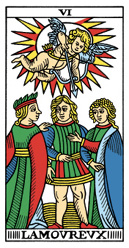
The Lover
The common interpretations of the card speak of love or choice. But when I looked at the figure of the man between the two women, one younger and the other older, I felt that the card presented an image of the relationship itself. Often we can see in the card a man who is in a complex relationship, with his female partner on the one hand and with his mother on the other hand. But something in the querent’s presence made me approach the image from a slightly different direction. Instead of concentrating on the relationship between the querent and his own mother, I asked him what was happening between him and the girl’s mother. His answer was that indeed there was some flirting going on between them, and this caused tensions and quarrels in his relationship with her daughter.
In another instance, a woman told me about the difficulties she was experiencing in different aspects of her life, including her relationships with men. Two cards that appeared side by side attracted my attention: the Star, followed by the Emperor to its right.
Usually the Star is regarded as an expression of sincerity, purity, and innocence, while the Emperor represents a strong and protective figure. But at that particular moment I felt something sinister in the picture of an overpowering man waving his masculine-looking club over a naked and cramped woman. In such matters one should be delicate enough not to pose a direct question, but I threw a hint in the air. The querent caught it and told me that she had been sexually assaulted by a relative at a young age and had never spoken about it.
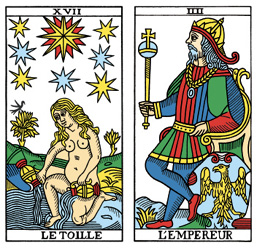
The Star, The Emperor
Once such a spontaneous interpretation appears, it becomes a part of our collection of tools for future readings. But we should also be careful not to become too attached to it. We should not think of a sexual assault every time we see this card combination. One can see completely different stories in the combination of the same cards. For example, it can represent a woman who allows herself to be exposed and vulnerable because of the protective and confidence-inspiring presence of her partner. But, as we shall see in the next chapter, the gender roles can also be reversed — that is, the masculine figures in the cards may also represent women in real life, and vice versa.
Before we start reading the cards, we must arrange them on the table. For this we have to choose a spread layout. In tarot books and on websites, one can find a huge collection of spreads, some simple and others very complicated. From this collection each reader chooses a small set of several spreads that can be used for different types of questions. Many readers also invent spreads of their own.
In the open reading approach there is no need for large, complicated spreads. The cards’ illustrations themselves are rich enough. They offer different aspects and possibilities, especially if one uses the powerful illustrations of the Tarot de Marseille. Too many cards on the table can also distract our attention from a difficult or challenging card, increasing the chances that we will be tempted to ignore it.
As I learned from Jodorowsky, for almost all types of queries we can use a basic spread of three cards out of the twenty-two of the major suit. This is a recommended option, especially for beginning readers who don’t yet know the minor suit cards well enough. But many French tarot readers use it throughout their career, feeling that three major cards from the Tarot de Marseille are enough to produce a deep and productive reading. The three cards are laid down in a row from left to right and then read as a story, which normally advances in this direction.
The path Jodorowsky followed in order to reach this minimal spread is interesting. He used to tell how, during his first years with the cards, he started laying out the spreads with more and more cards. Since the cards of one deck were not enough, he would shuffle together three decks. The table soon wasn’t large enough anymore, so he started spreading on the floor. He would lay down the cards like a large maze and physically lead the querent through the spread while reading it. But then he realized that there was no end to this process; one could always add more and more cards and still feel that it wasn’t enough. Jodorowsky stopped his quest for ever bigger spreads, and afterwards he almost always used the basic spread of three cards from the Marseille major suit.
There are also cases in which a single card is read. For example, in a workshop we can have each participant pick up a card and discuss it with the whole group or with another participant. Also, sometimes in a reading session I ask the querent to draw a single card (usually from the twenty-two majors) in order to clarify a specific point. But in a normal reading session, a single card is usually not enough to describe the various and usually complex aspects of a personal issue.
In many tarot books, a spread layout usually appears as a geometric arrangement of empty frames, each one with a description of what it represents in the reading. For example, in a typical spread layout there may be one position representing the past, another representing the future, other representing the querent’s hopes or fears, strengths or weaknesses, the influence of their environment, and so on. As the cards are put down on the table, each one of them is interpreted according to its position. The important point is that in this conventional approach, the function of each position is fixed in advance before the cards are laid out.
In the open reading approach, though, the spread layout is treated differently. It only tells us how many cards to draw and how to arrange them on the table; it does not tell us in advance the function of each position in the spread. Before we see the cards on the table, we can’t say what each of them represents: the querent’s past or future, weaknesses or strengths, or anything else. Instead of using predefined functions, in the open reading we look at the cards and try to understand the role of each one in relation to the full spread.
For example, when we use the basic three-card spread and read it from left to right, it may happen that the left card would represent the past, the middle card represent the present, and the right card represent the future. Yet in many cases the roles of the cards may be different. Sometimes the figure in the middle is the querent, and the two cards on both sides are two paths, two tendencies, or two possibilities open before them. We can see such a thing in the following spread:
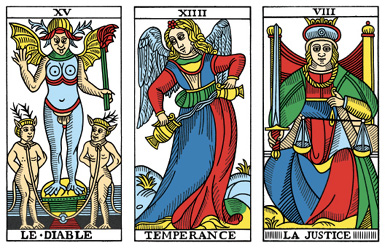
The Devil, Temperance, Justice
Even without knowing the common interpretations of the cards, we can feel the contrast between the Justice card, expressing rigidity and firm structures, and the wild, unruly passions of the Devil card. The figure of Temperance in the middle mixes liquids from two jars. She may be expressing a compromise or a combination of the two elements represented by the two sides: normative and orderly behavior on the one hand, impulsive passions and breaking of rules on the other.
Sometimes one of the cards has a visual presence that stands out among the others. For example, it can be especially colorful and dramatic, or the figures on the other cards may all be looking at its direction. When this happens, it’s possible to see the outstanding card as expressing the main issue of the reading, regardless of its position on the right, on the left, or in the middle. We can see something like this in the following spread:
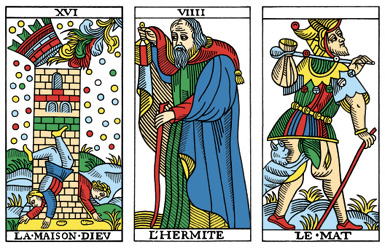
The Tower, The Hermit, The Fool
The Tower card is full of action, color, and drama. Maybe it represents a crisis or some sort of drastic change in the querent’s life. In the middle card we see the serene hermit figure looking at the event with a concentrated look, as if trying to figure out its meaning. On the right the fool turns his back to the event and goes away in a new direction.
We can interpret this arrangement from left to right as a timeline: a crisis, then trying to figure out the implications of what happened, and finally embarking on a new path. Yet it may be that all the phases of the process have already occurred, so that the three cards represent the past, or maybe all three speak of a possibility that can happen in the future. Alternatively, we can read the whole sequence not as a time sequence but as a question of choice. In this interpretation what has happened is already there. Now the querent should decide whether to stay fixed on the past, as in the middle card, or to let go of it, put on his shoulder whatever assets that he can take with him, and walk away to find something new.
There are many more ways of reading the basic three-card spread. One can see the middle card as the heart of some issue and the two side cards as two aspects of it. One can follow a traditional language of symbols and see the right card as an active and outgoing factor, the left card as a passive and receiving factor, and the middle card as a combination or compromise between the other two. One can also see the middle card as the querent, the right card as what helps them, and the left card as what obstructs them.
The Full Picture
Conventional tarot textbooks often present the reading as going from the details to the whole — that is, from the single cards to their combination in the spread. According to this approach, we first interpret each card separately, taking into account its customary interpretation and the predefined role of its position in the spread. Only then do we combine the interpretations of the different cards into a complete answer. In contrast, the open reading advances from the whole to the details. First we try to grasp the full picture formed by the combination of cards. Only then do we proceed to analyze the role of each figure or image detail and its contribution to the whole picture.
This difference is significant, especially in the first minutes of the reading. Sometimes when the cards are laid down we may have a feeling that one of them already gives a definite answer, but it’s not a good idea to become fixed on this. When we examine the full picture, things might look different. Instead of searching for the final answer right away, it is better to free our mind, look at the combination of cards in front of us, and try to understand what characterizes the spread as a whole.
The first things that may attract our attention are the human figures. We can start by checking where each figure is looking — in what direction and at what object or figure, whether in its own card or in its neighbor. We note whether the figures are making eye contact or avoiding each other’s gaze. We try to figure out what their posture and body language express. They may be moving toward each other or away from each other, or maybe one is trying to get closer but the other is blocking him. We try to feel their emotional attitude toward each other. At this stage we don’t need to understand right away how what we see is linked to the querent’s story. This may come later.
Another thing to notice is the general composition — that is, lines or surfaces that connect neighboring cards or lead from one card to another. Sometimes an oblong object in one card will continue the line marked by objects in other cards, and sometimes it will block or divert it. The flow lines of objects or surfaces in neighboring cards may approach each other or move away from each other. They may also meet at some point in yet another card. It’s a good idea to identify flow lines that cross all the cards in the spread. Such lines may indicate a direction for the whole layout.
Often we can see shapes or surfaces that continue from one card to another. Same-color surfaces in neighboring cards may join to form one shape. Parallel lines of earth or water in one card may meet with similar areas in the next card. The horizon and the ground shapes may continue from one card to another. In other cases we can see cards that are disconnected from each other, such as a card with long vertical lines blocking the flow of lines and surfaces from the neighboring card. This way we can get a feeling about the continuity or the break between the cards.
Apart from such continuing lines and shapes, there are other kinds of links that can connect different cards. Sometimes we can see the same arrangements of figures in different cards; for example, two small figures side by side or one figure above and two figures below it. If such a structure repeats itself in several cards, it may represent different phases or different aspects of the same situation or relationship.
We also can notice repeating numbers of objects; for example, a group of three objects appearing in each card. The objects themselves may be different, but their number and perhaps also their arrangement (for example, in a triangle) will be the same. In such a case we can see the number as indicating something about the spread as a whole. The meaning of this number can be literal if the question involves a quantity, a date, and so on. For example, three objects can represent three children or three months. But it can also be symbolic, in which case we may interpret it using the symbolic language in the next chapter. For example, four objects arranged in a square can indicate a stable structure.
In other cases we may notice connections between the card numbers; for example, a spread with three consecutive numbers, such as 3, 4, and 5. These cards may indicate sequential phases of a process, and it is interesting to compare the order of the card numbers with their ordering in the spread. For example, if the card numbers read from left to right follow each other in an increasing order (3, 4, 5), it signifies an ascent and development; if they form a decreasing series (5, 4, 3), it may mean retreat or decline.
Sometimes we may notice a resemblance between figures in different cards. This may indicate that they represent a single person or maybe different people acting in a similar way. We may also see a similar object appearing, with slight differences, in two or more cards. For example, it can be a wand or a stick that each figure holds, a crown on each figure’s head, or common clothing items between the figures. In such a case we can think about the symbolic meaning of the common object. For example, a crown may represent a dominating position (the king of the situation) or perhaps wisdom (stressing the upper head). A wand or a stick may remind us of the suit of wands, which represents activity, desire, and creation, as we shall see in Chapter 7. It may also happen that we find similarities in landscape details between the cards, such as a stone structure, a pool of water, or an opening in the ground.
More general characteristics of the figures can also appear in different cards. In one spread we might notice that all the figures are male, and in another spread they may all be female. It may be that in most of the cards the figures are naked, or maybe they are heavily clothed. Maybe most of them are shown in an open space, or maybe they are surrounded by closed and blocking constructions. All the figures may express power and authority or maybe weakness or delicateness. Sometimes all the figures in a spread will be holding some objects in their hands, and sometimes some of them will have their hands empty or hidden.
If the same characteristic appears in all the cards in the spread, it may reflect an important feature of the situation or some essential quality that accompanies the querent in different stages of the process. To give it a meaning, we can rely on the symbolic language outlined in the next chapter, on suggested interpretations appearing elsewhere in this book, or on our own intuition and general knowledge. It’s also possible to point it out to the querent and ask them how they feel about it or what it brings to their mind.
Some Examples
Here are some examples of the basic three-card spread and its interpretation in the open reading approach. Of course, the story given here is not the only possible way of reading each card combination. It may be a good exercise to look at the spreads yourself and to give them your own alternative interpretations.
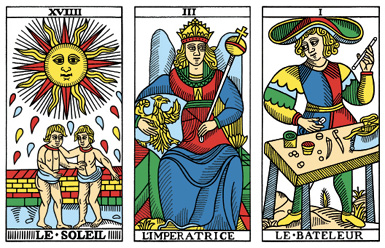
The Sun, The Empress, The Magician
The Empress figure at the center may be a married woman, whose children appear in the left-hand card. The sun above them can represent the father of the family: leading and providing but also “in the sky” — that is, remote and not really accessible. Maybe he is too busy with his career or other occupations and doesn’t find the time and energy to invest in close emotional contact with his wife and children.
A young man now appears in her life, represented by the Magician on the right. He is light-spirited and avoids commitment, as the fancy clothing and the legs spread to both sides indicate. But as an illusion-weaving showman he may also have personal charm and courting tricks. His stare at her body indicates that he is interested in a sexual relationship with her.
The sitting position in the well-protected chair shows that, at this stage, she remains loyal to the family framework. She embraces the eagle coat-of-arms, which is a symbol of the royal family, and holds her scepter as a barrier in front of the new man’s face. But her eyes directed toward him indicate that the attraction is mutual, and the white scepter handle based on her pelvis can suggest an open way in which her desire can move forward. We can conclude that if the woman’s husband doesn’t wake up to give her more attention, it is likely that, sooner or later, she will succumb to the young man’s advances.
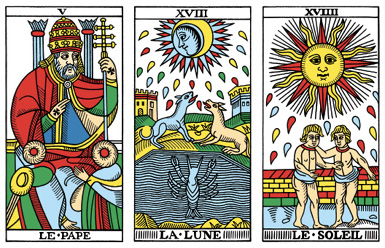
The Pope, The Moon, The Sun
The Pope in the left-hand card can represent a teacher or a father, and the two small figures seen from behind may be two students or children. His attention isn’t divided equally between them, and it seems as if it is more oriented toward the one on the right. Perhaps one of the brothers feels rejected, not getting as much of their father’s attention as his brother.
In the upper part of the middle card we see the moon replacing the Pope. Maybe the father figure has died and now he is “in heaven.” In his absence, strong animal-like emotions of jealousy and mutual resentment arise between the brothers, represented by the two dogs barking at each other. The crustacean at the bottom of the card can indicate deep and dark feelings rising to the surface. The moon face looking toward the first card can indicate that the present relationship is still motivated by past emotions.
The card on the right can be seen as a reparation of the fraternal relationship. The two figures are once again human. Their mutual touch expresses warmth and trust, and the mythological father figure in the sky is shining light equally on both of them. It is as though they have overcome their jealousy and the old competition for the deceased father’s attention, understanding that both did, in fact, benefit from it.
The following story appeared some years ago on an Internet tarot forum. A woman who described herself as a devoted employee in a big organization found herself the object of her immediate boss’s attentions. He was a married man, and she had no romantic interest in him. She felt confused, blamed herself for the situation, and wondered whether she should give in to his advances or look for another job. In her distress she drew three cards from a full deck (including the major and the minor suits) and asked the forum members for advice. She didn’t say which deck she was using, and probably it was not the Tarot de Marseille. Still, I felt that a significant answer could emerge from the Marseille counterparts of her cards. These were:
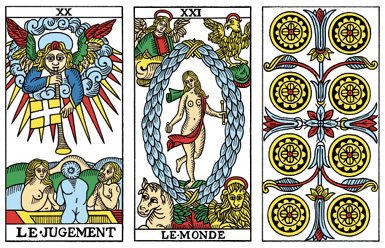
Judgment, The World, 8 of Coins
Looking at the World card in the center, and in spite of her own subjective feeling of helplessness, I could see her as the active figure in the spread. The dancing posture indicated that even within the limited space available to her, she can still find freedom to maneuver. As to the two objects in her hands, these may represent two options that she can put in front of her boss.
The Judgment card on the left, with a trumpet whose sound is heard far and wide, represents one option. The central figure seen from the back is rising from a hole in the ground, possibly indicating hidden things being revealed in broad daylight. The dramatic character of the card shows what will happen if she chooses this option: to blow the whistle and make a public scandal. It would surely hurt him and possibly ruin his career.
The other option is represented by the card on the right with a solid and regular pattern of coins, possibly representing the ongoing routine of a workplace. The pairs of coins layered on top of each other may also symbolize an office building or simply the orderly structure of management and subordination in a big organization. In this option everything returns to normal: no more harassment, no ruining of career and personal life, everyone goes back to work as if nothing ever happened.
My advice was that she let him realize this perspective, not by making an explicit menace but by giving a clear hint that now it is she who has power over him. His own fears would do the rest and make him go for the second option. As the querent later wrote in the same forum, this is exactly what happened.
When I do consultations at home, I usually put enlarged copies of the cards on a board behind me so that the querent can see them and understand what I am talking about. Often I leave the cards on the board after the reading, and later when I look at them I can see meanings for myself. It is in this way that I got the following combination of cards. It appeared when I was mourning the loss of an old friend who died while I was preparing this book. My feelings and my thoughts were occupied with heavy questions about the meaning that we may find in our life and about the role of choice and giving.
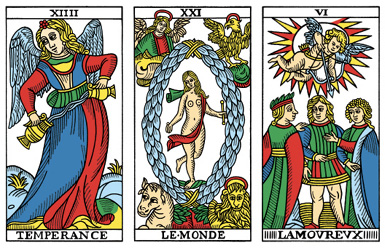
Temperance, The World, The Lover
The dancing figure appears again in the center of the spread, but now all the other elements in the cards surround it in what looks like layers over layers. This image may represent the innermost part of our being, from which we make the meaningful choices in life. On the left we see a self-centered figure who lives only by and for herself, keeping others at a distance and guarding her personal space with her elbows. The two pots she is holding can symbolize the pot of resources and the pot of needs. The figure pours from the first pot into the second, fulfilling her own desires and needs while leading a comfortable life of self-gratification. But as she becomes older the pot of resources diminishes and the pot of needs becomes heavier. Eventually a moment comes when the resources are insufficient to fill up the needs, and then there is no real reason to prefer life over death.
On the right we can see a man standing between two women. His head is turned toward one of them, but the rest of his body leans toward the other one. He may be hesitating over which one to choose, and Cupid’s arrow from above indicates that he really loves the one on his right. She has her hand on her belly, which may indicate a future pregnancy and the formation of a family. But for this to happen he must forgo the other woman — that is, to make a choice, to commit himself, and to pay a price. This is the kind of commitment that we can take for the sake of a life partner, a child, or maybe another person or cause that we really care about. It requires us to give up the fulfillment of some of our needs and desires. But in such a situation, if we die, this will cause sorrow and pain to people that we are committed to. This feeling can provide us with a good enough motivation to go on living.
Finally, during the restoration work on the CBD Tarot de Marseille, I printed a draft copy of the final version of the cards. The first spread I did to inaugurate the cards was about the CBD deck itself. I was wondering what the cards could tell me about themselves and about the process of making them.
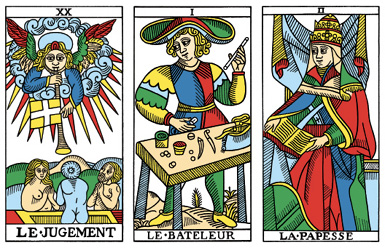
Judgment, The Magician, The Popess
The Magician, who brings his tools in a bag and spreads them on the table, looks like an artisan, but not an accomplished one: the young face and the number 1 indicate a beginning stage. This reflects how I felt. I had brought my previous knowledge and tools to the process, but now I was trying to apply them in a domain of graphic design and printing that was new to me.
The Judgment card on the left, receiving the gaze and attention of the figures in the other cards, could represent the restoration process. The figure in light blue rising from the earth, hinting at the Christian resurrection of the dead, may be Conver’s deck again coming to life in a new body of paper and color. The man and the woman on each side may be the female illustrator and the male graphic designer who worked for me, while the angel above may represent the feeling that accompanied me, as if the project was not really directed by my own decisions and preferences. At key moments things would happen beyond my control, compelling me to change direction — and, in retrospect, I could see that these changes were always productive and necessary. So, in my feeling, the angel could represent the “spirit of the cards” guiding things and making choices that proved better than those I could make on my own.
The Popess appears in the right-hand position, which normally represents the future. But her coverings and the veil behind her hint at mystery and things unknown. Maybe it’s simply the uncertainties about outcomes — how the deck of cards will look in the final print, what feelings it will awaken in people, and what they will do with it. But maybe it is also about the mystery of the cards themselves, whose magical power still continues to enchant me after this experience of plunging into them as they break up into a myriad of surfaces, lines, and pixels. And finally, the book in the Popess’s hands could be just the tarot deck itself, which is put in front of anyone who wishes to read it and to get hints about what is hidden behind the veil.
Inverse Cards
Except for some of the number cards in the minor suits, most of the Tarot de Marseille cards are not vertically symmetrical. This means that there is a clear difference between a card that is straight (with the earth below and the sky above) and an inverse card (the other way around). There are several approaches to inverse cards. Some tarot readers ignore the matter altogether and read all the cards as straight. For beginners, this is often a recommended way. However, more advanced readers may prefer the broader range of possibilities and nuances that inverse cards may offer.
Fortunetelling methods sometimes adopt the opposite approach and regard the inversion of a card as an inversion of its meaning. For example, if it’s a card whose straight meaning is deprivation or failure, then inverse it will signify abundance or success. This approach is problematic if we consider the visual aspect of the card. For example, a card with heavy atmosphere and dark colors does not become happy and bright when inverted.
In the open reading approach, the inversion of cards can be interpreted at several levels of meaning. The first level is similar to the way many tarot books treat the subject. When a card appears inverse we shall read it as the same factor working in the opposite direction, which is contrary to the querent’s wishes or interests. This means that the inversion stresses the less positive aspects of the card.
In the lists of card meanings offered later in this book, I include a number of possible interpretations for each card, some of which are favorable or positive, while others are challenging or negative. When the card is inverse we can put more weight on the challenging and negative aspects. For example, if the figure on the Star card spills her water to the ground, it may indicate overflowing generosity and abundance. In an inverse card we may interpret it as wastefulness and squandering.
While this approach may be useful, we may feel that it is still too formal and doesn’t relate to the most basic fact about inverse cards: when a card is inverse, it looks different. Therefore, to go deeper into the meaning of an inverse card, we need to consider the visual effect of its inversion.
An important visual change in the inverse card is in the relation between the sky and the ground. The white sky in the Tarot de Marseille gives an impression of openness and lightness, which is made weaker when the ground is on top. In addition, the reversal changes the visual flow lines of the card image, and this can also create a different impression. For example, the Moon card in a straight position generally has a heavy and closed character, but the image still suggests an upward movement. When the card is inverse, the earth and the pool above intensify the feeling of heaviness and closeness, and now the movement is downward. This may strengthen the association of the card with hard and depressive feelings.
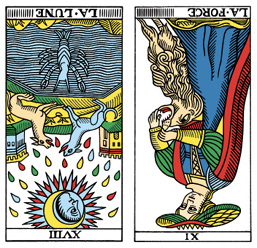
The Moon (inverse), Force (inverse)
A card inversion also changes the symbolic relation between the top and the bottom. For example, in the Force card we see a woman’s head above and a lion’s head touching the woman’s pelvis below. We can interpret this image as the intellect (head) controlling the animal desires and impulses (pelvis, lion). When the card is inverted the animal is on top, and this may indicate that the querent’s desires are more dominant than their rational self-control.
An inverse card also plays a different role in the full picture. A figure facing right in a straight card will face left when the card is inverse, so that its gaze and posture will relate differently to figures in other cards. The flow of lines and shapes between neighboring cards will also be affected by the inversion. To appreciate these changes it is useful to turn the card around to the straight position and compare the two situations.
An important point to remember is that straight and inverse are only a matter of perspective. When we look at an inverse card from the opposite side, it looks straight. For example, if I see a spread with all or most of the cards inverted, I often interpret it as a need for the querent to change their attitude or point of view so as to see the cards from the other side. Looking at things in a new perspective, the same factors can now be going with them and not against them.
An interesting situation is the appearance of cards with figures that are originally drawn upside down. These are the major cards of the Hanged Man, the Tower, and one of the figures in the Wheel of Fortune. If we identify such a figure with the querent and one of the other cards is inverse, then from the querent’s unique point of view that card is straight. In other words, what others see as a disadvantage, the querent can see as an advantage.
When inverse cards appear in the reading, it is not necessarily a negative thing. The card is already there on the table, and we can simply stretch our hand and straighten it. In other words, the factor or influence represented by the card is already present in the querent’s life. There is no need to bring in new elements. Instead, the querent can try to turn around the existing elements so that they work in the querent’s favor.
An inverse card can thus indicate a point where the querent can improve their situation with resources that they already have available. This makes inverse cards especially meaningful. During the reading I usually straighten up inverse cards one by one in order to understand what changes the querent can make in their life and how things will look if they do so. We can see such a thing in the following example:
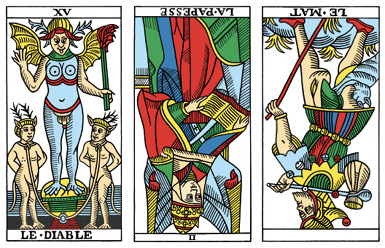
The Devil, The Popess (inverse), The Fool (inverse)
The Devil card on the left may symbolize a particular kind of romantic relationship. It is full of passions and desires, but at the bottom lies a dark underground level. The two little imps tied at their necks can symbolize the partners in the relationship, who cannot break their mutual bond even if they feel it is unhealthy. The Popess can be a woman with high abilities and intelligence, but inverse she lowers herself and sees herself as weak. The many covers around the figure may express disconnection and enclosure in an inner, secret world of her own. The inverse Fool card describes the confusion and the loss of direction she feels, her gaze fixed on the relationship from which she can’t detach herself.
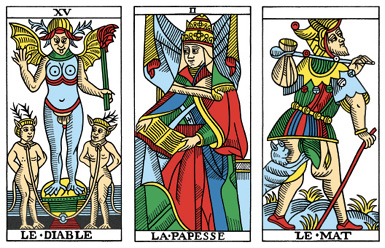
When we straighten the Popess card, though, she becomes aware of her strengths. Now she looks at the relationship from a position of comprehension and some detachment. The closed character of the card may now express that she is able to keep up her boundaries. The Fool card, when straightened, shows the possibility of leaving the problematic relationship behind and embarking on a new path. We can understand that for this to be possible, the querent should first straighten the middle card and try to improve her own self-esteem.
A technical matter, yet an important one, is how to get inverse cards from the shuffle. There are different ways of doing this, and here is mine. After I take the cards out of their box, I shuffle them in my hands. Every now and then I stop, split the deck into two parts, and rotate one of them so as to invert the orientation of the cards. Having done that, I recombine the two parts into one pack again. I continue to shuffle, stopping once again to split and rotate one part. I repeat this several times. Now I hand the deck to the querent and ask them to do the same: to shuffle, invert one part, shuffle again, and so on, until they feel they have had enough.
If the querent is sitting in front of me, as is usually the case, then when they hand back the cards I consider them as straight or inverse from their point of view. However, as I take the cards from them, I see the cards from the opposite side. In order to see the cards from the querent’s perspective, I invert the whole deck once again, and only then do I draw the cards. I take care to draw the querent’s attention to this action. The reason for this is not to let them be confused seeing the cards from the other side while I speak of the cards as straight or inverse.